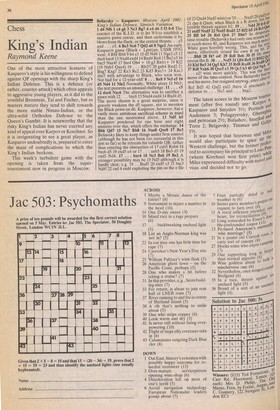King's Indian
Raymond Keene
One of the most attractive features of Kasparov's style is his willingness to defend against OP openings with the sharp King's Indian Defence. This is a defence (or rather, counter-attack) which often appeals to aggressive young players, as it did to the youthful Bronstein, Tal and Fischer, but as masters mature they tend to shift towards the more stable Nimzo-Indian, or the ultra-solid Orthodox Defence to the Queen's Gambit. It is noteworthy that the risky King's Indian has never exerted any kind of appeal over Karpov or Korchnoi. So it is invigorating to see a great player, as Kasparov undoubtedly is, prepared to enter the maze of complications to which the King's Indian beckons.
This week's turbulent game with the opening is taken from the supertournament now in progress in Moscow. Beliavsky — Kasparov: Moscow April 1981; King's Indian Defence, Samisch Variation.
1 d4 Nf6 1 c4 g6 3 Nc3 Be 4 e4 d6 5 0 0-0 The essence of the K.I.D. is to let White establish a massive pawn centre, and then undermine it by blows from the flank, or the central thrusts. . .c5 and. . . e5. 6 Be3 Nc6 7 Qd2 a6 8 Nge2 An earl Kasparov game (Black v Lputjan, USSR 197 went: 8 Rbl Rb8 9 b4 e5 10 c15 Nd4 11 Nge2 c5 12 dxc6 bxc6 13 Nxd4 exd4 14 Bxd4 Re8 15 Be2 c5 16 bitc5 Nxe4! 17 fxe4 0h4 + 18 g3 Rxbl + 19 Kf2 (19 Nxbl Qxe4) 19 . . . Rb2!! 20 gxh4 Rxd2 21 Bxg7 Kxg7 22 Ke3 Rc2 23 Kd3 Rxc3 + 24 Kxc3 dxc5 with advantage to Black, who soon won. Not bad for a 12-year-old! 8. . . Re8 9 Ncl e5 10 d5 Nd4 11 N1e2 Normally, White plays 11 Nb3; the text presents an unusual challenge. 11 . . . c5 12 dxc6 Nxc6 The alternative was to sacrifice a pawn with 12 . . . bxc6 13 Nxd4 exd4 14 Bxd4 d5. The move chosen is a great surprise, since it gravely weakens the d5 square, not to mention the Black pawn on d6. Kasparov, however, has a vastly more ambitious sacnficial scheme in mind than the one mentioned above. 13 Nd5 b5 Kasparov pondered for one hour and eight minutes over this, which offers the exchange. 14 Bb6 Qd7 15 Nc7 Rb8 16 Nxe8 Qxe8 17 Be3 Beliavsky likes to keep things under firm control (although he has not been too successful in this aim so far) so he retreats his valuable QB, rather than entering the obscurities of 17 cxb5 Rxb6 18 bxc6 d5 19 exd5 c4 or 17 . . . axb5 18 Be3 d5 19 exd5 Nd4. 17 . . . bxe4 18 Nc3 Be6 19 Be2 A stronger possibility may be 19 Nd5 although it is
hardly clear, e.g. 19 Bxd5 20 exd5 c3 21 bxc3 Nd4! 22 cxd 4 exd4 exploiting the pin on the e file
Spectator 18 April 1981 (if 23 Qxd4 Nxd5 win's) of"19 . Nxd5 20 excl5,,e01 21 dxe 6 Qxe6, when Black is a R down, 10.'1,5 terrible threats against b2. 19 . . . Nd4 20 0-0,‘."4 21 exd5 Nxd5 22 Nxd5 Bxd5 23 R0 h5 24 gel w-te 25 Bfl h4 26 Rel Qc6 27 Bh6? In desperisit time-trouble (Beliavsky had only one minute 'CA to reach move 40, and Kasparov not much lunt'it White goes horribly wrong. This, and his ri move, effectively strand his own B on h6. .11h8 28 f4? eel! 29 Rdl Be6 30 f5 He nitless rescue the B. 30. . . Nxf5 31 Qf4 Re8 32 Rfd2 33 Khl Be5 34 Qg5 Kh7 35 Rd8 Rxd8 36 RxdS QAT) 37 Rdl Nxh6 38 Qxe5 e3 39 Qc3 h3 40 Qe1 Ng4c:LI . . . e2! wins more quickly. This was the "A-0 move of the time-control. Now Beliavsky had 41 his move, but resigned anyway, since after Rd Bd5 42 Qxf2 exf2 there i‘ absolutely no
defence to . Ne3 and . . . hxg2.
The latest scores in the Moscow touril; ment (after five round) are: Karpov %A Kasparov and Smyslov 31/2; Portisch Andersson 3; Polugayevsky, GheorghltiA and petrosian 21/2; Balashov, Smejkal Torre 2; Belgavsky, Timman and Gehe' Ph. It was hoped that Seirawan and Miles the would also participate to spice UP Western challenge, but the former preferred to accompany his principal to Lone Piflie (where Korchnoi won first prize) wIlucl Miles experienced difficulty with travel an visas and decided not to go.






































 Previous page
Previous page